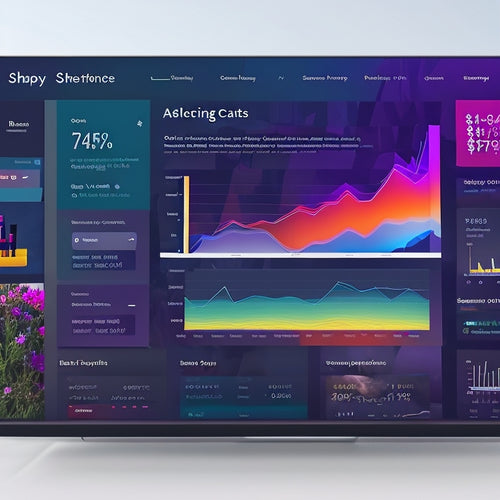
Integrating Digital Solutions for Ecommerce Success
Share
By integrating digital solutions across your ecommerce ecosystem, you'll open streamlined operations, personalized customer experiences, and data-driven decision making. Automate order fulfillment to reduce errors and increase customer satisfaction. Enhance customer experiences through seamless shopping journeys and AI-driven chatbots. Leverage data analytics to optimize inventory management, supply chain logistics, and marketing efforts. Additionally, boost conversion rates with tailored product recommendations, secure payment gateways, and optimized content delivery. As you weave these digital solutions together, you'll set the stage for accelerated growth and long-term success - and discover even more opportunities to propel your ecommerce business forward.
Key Takeaways
• Integrating digital solutions streamlines order fulfillment, reducing shipping errors, and increasing customer satisfaction, while optimizing inventory levels and demand forecasting.
• Automating and optimizing inventory management systems prevents stockouts, overstocking, and lost sales, ensuring swift responses to market conditions and changes.
• Leveraging data analytics insights uncovers hidden patterns, identifies opportunities, and optimizes ecommerce strategy for maximum ROI, driving business growth and revenue.
• Implementing secure payment gateways, such as tokenization and two-factor authentication, safeguards sensitive customer information, ensuring trust and loyalty.
• Boosting conversion rates through streamlined checkout processes, A/B testing, and mobile-responsiveness enhances user experience, leading to significant revenue growth and increased customer loyalty.
Streamlining Order Fulfillment Processes
Simplifying Order Fulfillment Processes
By automating and integrating your order fulfillment processes, you can reduce shipping errors, lower operational costs, and increase customer satisfaction. This is achieved by optimizing order processing, which involves implementing efficient workflows that minimize manual interventions.
With automated order processing, you can process orders faster, reduce errors, and allocate resources more effectively.
Inventory optimization is another vital aspect of streamlining order fulfillment. By leveraging advanced analytics and machine learning algorithms, you can accurately predict demand, optimize inventory levels, and reduce stockouts or overstocking.
This not only saves you money but also guarantees that you have the right products in stock when customers need them. By integrating inventory optimization with order processing, you can create a seamless fulfillment experience that delights customers and drives business growth.
With digital solutions, you can create a highly efficient and responsive order fulfillment process that sets your ecommerce business apart from the competition.
Enhancing Customer Experience Journeys
As you focus on enhancing customer experience journeys, you're likely thinking about how to create a cohesive and engaging experience across all touchpoints.
To achieve this, you'll want to guarantee smooth shopping shifts and seamless online interactions that eliminate friction and build trust with your customers.
Smooth Shopping Transitions
By smoothly integrating multiple touchpoints, you can craft a cohesive shopping experience that effortlessly guides customers through every stage of their journey, from product discovery to post-purchase support. This harmonious flow is critical in building trust and loyalty with your customers.
To achieve this, focus on creating user-friendly interfaces that facilitate smooth progress between different stages of the shopping journey. Guarantee that your website and mobile app have mobile optimization and responsive design, allowing customers to navigate effortlessly across devices.
Here are some key benefits of smooth shopping progress:
-
Reduced bounce rates: A seamless experience keeps customers engaged, reducing the likelihood of them abandoning their carts.
-
Increased conversions: Streamlined shopping journeys lead to higher conversion rates, as customers can easily find what they're looking for.
-
Improved customer satisfaction: A cohesive experience builds trust and satisfaction, leading to positive reviews and repeat business.
- Enhanced brand reputation: A well-designed shopping experience reflects positively on your brand, setting you apart from competitors.
Seamless Online Interactions
Through intuitive interface design and cleverly crafted interactive elements, you can orchestrate seamless online interactions that anticipate and respond to your customers' needs, fostering a deeply personalized and engaging experience. By prioritizing user-friendly interfaces, you'll streamline the browsing and buying process, reducing friction and increasing conversions. Seamless transactions become the norm, as your customers effortlessly navigate your site, free from frustration and hesitation.
To take it to the next level, leverage interactive platforms that encourage customer engagement. Implement AI-driven chatbots, for instance, to provide 24/7 support and address customer queries in real-time. This not only resolves issues promptly but also allows you to gather valuable insights into customer behavior and preferences.
Leveraging Data Analytics Insights
You can pinpoint areas of improvement in your ecommerce strategy by tapping into the wealth of information hidden within your sales data, customer interactions, and market trends. By leveraging data analytics insights, you'll uncover hidden patterns, identify opportunities, and optimize your strategy for maximum ROI.
Here are just a few ways data analytics can revolutionize your ecommerce approach:
-
Uncover hidden sales opportunities: Predictive analytics helps you identify high-value customer segments and tailor your marketing efforts to maximize conversions.
-
Streamline your supply chain: Data analytics reveals bottlenecks and inefficiencies in your logistics, enabling you to optimize inventory management and reduce costs.
-
Personalize the customer experience: Customer segmentation allows you to tailor your marketing messaging and product recommendations to individual preferences, driving loyalty and retention.
- Stay ahead of the competition: Real-time market trend analysis enables you to respond quickly to changes in the market, staying one step ahead of your competitors.
Optimizing Inventory Management Systems
When optimizing your inventory management system, you're likely looking for ways to streamline operations and reduce costs. By implementing automated stock tracking, you'll gain real-time visibility into your inventory levels, enabling you to make data-driven decisions that prevent stockouts and overstocking.
With this foundation in place, you can then focus on fine-tuning your order fulfillment process to guarantee timely and accurate shipments.
Automated Stock Tracking
By integrating automated stock tracking into your ecommerce operation, you can revolutionize inventory management systems, ensuring accurate real-time product availability and streamlining logistics. This means you'll have a clear picture of your stock levels at all times, reducing the risk of overselling or running out of popular items.
With automated stock tracking, you'll experience:
-
Inventory accuracy: Say goodbye to manual counting and hello to precise stock levels, updated in real-time.
-
Automated alerts: Receive notifications when stock levels reach a certain threshold, ensuring you're always prepared to restock.
-
Stock optimization: Use predictive analytics to identify slow-moving items and optimize your inventory accordingly.
- Data-driven decision making: Make informed decisions about product pricing, promotions, and inventory investments, backed by cold, hard data.
Real-time Inventory Updates
Accurate real-time inventory updates enable ecommerce businesses to respond swiftly to changing market conditions, ensuring inventory management systems stay optimized and aligned with customer demand.
You can't afford to have outdated inventory information, as it leads to stockouts, overstocking, and lost sales. By leveraging digital solutions, you can achieve inventory accuracy and streamline your supply chain. This allows you to make informed decisions, reduce stockouts, and prevent overstocking.
With real-time updates, you can also improve demand forecasting, enabling you to stock up on fast-selling items and avoid dead stock. This results in optimized stock levels, reduced waste, and increased revenue.
Additionally, real-time inventory updates enable you to identify trends and patterns, allowing you to refine your stock optimization strategies. By integrating digital solutions, you can create a seamless and efficient inventory management system that drives your ecommerce business forward.
Efficient Order Fulfillment
You can turbocharge your order fulfillment process by implementing a digitally-driven inventory management system that automates tasks, streamlines logistics, and guarantees that orders are shipped quickly and accurately. This means you'll be able to tackle the most critical aspects of order fulfillment, such as:
Reducing order errors: With automated inventory management, you'll minimize the risk of human error, ensuring that orders are fulfilled accurately and efficiently.
Boosting warehouse efficiency: By optimizing your warehouse operations, you'll be able to process orders faster, reduce labor costs, and increase customer satisfaction.
Streamlining shipping and logistics: With automated fulfillment, you'll be able to get orders out the door faster, reducing shipping times and costs.
Delighting customers with real-time updates: Keep your customers informed every step of the way, from order processing to delivery, to build trust and loyalty.
Boosting Conversion Rate Strategies
Optimizing your ecommerce site's user experience with intuitive navigation and streamlined checkout processes can greatly enhance the likelihood of converting browsers into buyers. By implementing conversion rate optimization (CRO) strategies, you can identify and address pain points that deter customers from completing purchases.
A/B testing is a crucial CRO tool that allows you to experiment with different design elements, such as CTAs, product layouts, and messaging, to determine which variations yield the highest conversion rates.
Moreover, a seamless user experience across devices is vital in today's mobile-first landscape. Guarantee your site is mobile-responsive, with fast loading speeds and effortless navigation, to cater to the growing number of mobile shoppers.
By prioritizing user experience and CRO, you can significantly enhance conversion rates, drive revenue growth, and stay ahead of the competition. Remember, every 1% increase in conversion rate can translate to thousands of dollars in additional revenue.
Implementing Secure Payment Gateways
By guaranteeing a seamless checkout experience, you've set the stage for the final hurdle: securely processing transactions, which is where implementing trusted payment gateways comes into play. This is where the rubber meets the road, and the integrity of your ecommerce platform is put to the test.
To instill confidence in your customers and protect your business from potential threats, you need to integrate secure payment gateways that prioritize fraud prevention and risk management.
Here are some key considerations to keep in mind:
-
Tokenization to safeguard sensitive customer information
-
Encryption to protect transactions in transit
-
Two-factor authentication to add an additional layer of security
- Compliance with industry standards (e.g. PCI-DSS) to guarantee adherence to best practices
Automating Shipping Logistics Operations
Streamlined shipping logistics operations can catapult your ecommerce business forward, slashing costs and boosting customer satisfaction through automated processes that pinpoint inefficiencies, eliminate manual errors, and fine-tune delivery routes.
By implementing shipping automation, you'll optimize your inventory levels, ensuring you have the right products in stock when customers need them. This, in turn, enables you to process orders faster and more accurately, reducing the likelihood of errors and misships.
To take logistics efficiency to the next level, you can leverage advanced algorithms that analyze order data and optimize delivery routes in real-time. This not only reduces shipping times but also lowers your transportation costs.
Additionally, with automated tracking and updates, you can keep customers informed about their orders, improving overall satisfaction and loyalty.
Personalizing Product Recommendations
As you work to create a seamless shopping experience, you're likely thinking about how to make your product recommendations more personal and relevant to each customer. By leveraging data and AI-powered algorithms, you can craft tailored product offers that resonate with individual shoppers.
Now, let's explore how you can take this strategy to the next level with smart product pairing and real-time suggestions that drive conversions.
Tailored Product Offers
You can greatly enhance average order value and customer satisfaction by leveraging AI-driven algorithms to create tailored product offers that resonate with individual shoppers' preferences and behaviors. By analyzing customer data and purchase history, you can craft customized promotions, personalized discounts, and tailored bundles that speak directly to their needs and wants.
These targeted offers can:
-
Increase average order value by up to 20% through strategic upselling and cross-selling
-
Boost customer loyalty by 30% through exclusive deals and personalized interactions
-
Drive conversions by 25% through tailored bundles and product recommendations
- Enhance customer satisfaction by 40% through proactive issue resolution and personalized support
Smart Product Pairing
Leveraging machine learning algorithms, your ecommerce platform can dynamically pair products that complement each other, increasing the likelihood of customers adding related items to their carts. This smart product pairing strategy, also known as dynamic bundling, enables you to offer personalized recommendations that resonate with your customers' needs and preferences.
By analyzing customer behavior, purchase history, and product relationships, you can create targeted promotions that drive sales and boost revenue.
To maximize the impact of smart product pairing, you can implement cross-selling strategies that suggest complementary products at strategic touchpoints, such as during checkout or on product pages. For instance, if a customer is purchasing a camera, your platform can suggest a compatible lens or tripod, increasing the average order value and enhancing the customer experience.
Real-Time Suggestions
Tap into the power of real-time suggestions by harnessing the capabilities of AI-driven product recommendation engines. These engines can analyze a customer's browsing and purchasing behavior on the fly to serve up personalized product recommendations that resonate with their unique needs and preferences.
By leveraging predictive analytics and customer insights, you can create a tailored shopping experience that drives engagement, increases conversions, and fosters brand loyalty.
With real-time suggestions, you can:
-
Surprise and delight customers with unexpected yet relevant product recommendations that feel like a personal touch
-
Reduce cart abandonment by suggesting complementary products that complete the purchase
-
Increase average order value by recommending premium or upgraded versions of products
- Streamline the buying process by suggesting products that are frequently bought together
Integrating Social Media Channels
By incorporating social media channels into your ecommerce strategy, your online store can reach a wider audience, increase brand awareness, and drive website traffic.
You can leverage influencer partnerships to promote your products to their followers, who are likely to be interested in your offerings. Social media campaigns can also be used to create buzz around new product launches or special promotions.
To maximize the impact of your social media efforts, focus on customer engagement. Respond promptly to customer inquiries and comments, and use social listening to stay on top of industry trends and customer concerns. This will help you build a loyal community of customers who'll advocate for your brand.
By increasing brand awareness through social media, you can establish your online store as a thought leader in your industry. Use analytics to track your performance and adjust your strategy accordingly.
With the right approach, social media can become a powerful driver of growth and revenue for your ecommerce business.
Improving Website Load Speed Times
Optimizing your website's load speed times is crucial, as every second of delay can lead to a significant loss of sales and revenue for your ecommerce business. You can't afford to lose customers due to a slow-loading website. Here are some alarming facts to take into account:
-
47% of customers expect a website to load in 2 seconds or less
-
40% will abandon a website that takes more than 3 seconds to load
-
A 1-second delay can lead to a 7% reduction in conversions
- 75% of users won't return to a slow-loading website
To avoid these pitfalls, focus on mobile optimization to ensure a smooth user experience across all devices. Implement image compression to reduce file sizes and enhance content delivery. Leverage content delivery networks (CDNs) to distribute your content across multiple servers, reducing latency and improving load times.
Frequently Asked Questions
How Do I Ensure a Seamless Transition to New Digital Solutions?
To guarantee a smooth shift, you'll need to prioritize training employees on new digital tools and develop a robust change management strategy, addressing potential roadblocks and resistance to maximize adoption and minimize disruption.
What Is the Ideal Ratio of Human to Ai-Powered Customer Support?
"You're drowning in customer inquiries, and AI alone can't save you! Aim for a 70:30 human-to-AI ratio, investing in training programs to upskill your team and exploring strategic outsourcing options to maximize efficiency and customer satisfaction."
Can I Customize Digital Solutions to Fit My Brand's Unique Needs?
You can absolutely customize digital solutions to fit your brand's unique needs, preserving your brand identity while driving innovation through personalization, allowing you to tailor experiences that reflect your vision and values.
How Do I Measure the ROI of Digital Solution Investments?
As you navigate the digital landscape, you're wise to wonder how to measure the ROI of your investments. Conduct thorough ROI analysis, tracking metrics that matter, and perform regular performance evaluations to guarantee a cost-benefit analysis that yields tangible results.
What Are the Most Common Digital Solution Integration Pitfalls?
When integrating digital solutions, you'll face implementation challenges and common mistakes, such as poor change management, inadequate testing, and misaligned expectations, which can lead to costly delays and revenue loss if not addressed proactively.
Related Posts
-
Enhance Your Shopify Store With Engaging Shoppable Videos
In the ever-evolving world of eCommerce, shoppable videos have emerged as a vital tool for online retailers. With a s...
-

Streamlining Your Business: The Power of Shopify ERP Integration
The integration of Shopify with ERP software offers a powerful solution for businesses, automating various processes...
-

Top Shopify SEO Apps for Boosting Website Performance
This article aims to examine the importance of utilizing Shopify SEO apps in order to enhance website performance. S...

